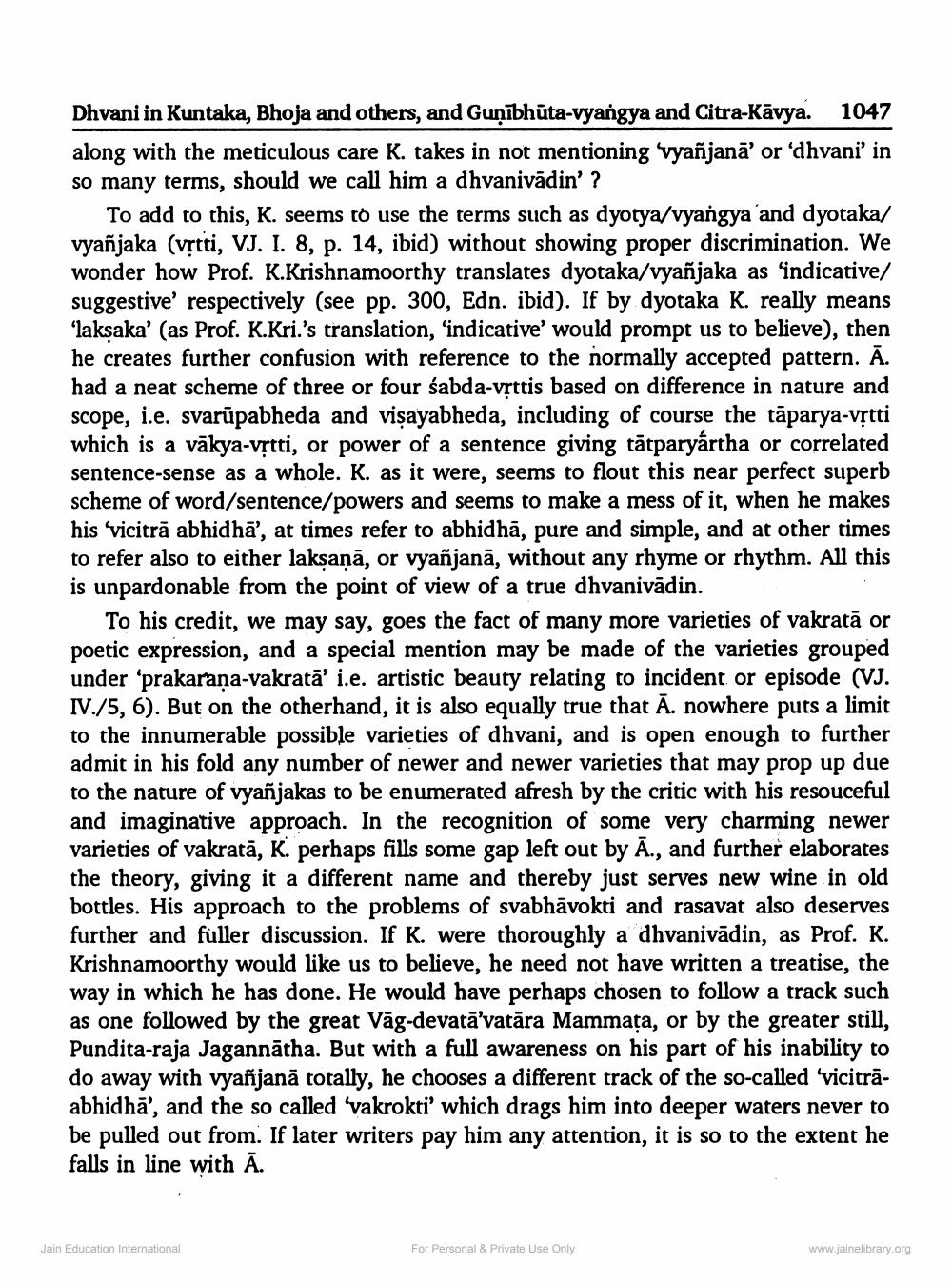________________
Dhvani in Kuntaka, Bhoja and others, and Gunībhūta-vyangya and Citra-Kāvya. 1047 along with the meticulous care K. takes in not mentioning vyañjana' or 'dhvani' in so many terms, should we call him a dhvanivādin'?
To add to this, K. seems to use the terms such as dyotya/vyangya and dyotaka/ vyañjaka (vľtti, VJ. I. 8, p. 14, ibid) without showing proper discrimination. We wonder how Prof. K.Krishnamoorthy translates dyotaka/vyañjaka as 'indicative/ suggestive respectively (see pp. 300, Edn. ibid). If by dyotaka K. really means 'laksaka' (as Prof. K.Kri.'s translation, 'indicative' would prompt us to believe), then ne creates further confusion with reference to the normally accepted pattern. A. had a neat scheme of three or four sabda-vrttis based on difference in nature and scope, i.e. svarūpabheda and vişayabheda, including of course the tāparya-vịtti which is a vākya-vștti, or power of a sentence giving tātparyártha or correlated sentence-sense as a whole. K. as it were, seems to flout this near perfect superb scheme of word/sentence/powers and seems to make a mess of it, when he makes his 'vicitrā abhidhā', at times refer to abhidhā, pure and simple, and at other times to refer also to either laksanā, or vyañjanā, without any rhyme or rhythm. All this is unpardonable from the point of view of a true dhvanivādin.
To his credit, we may say, goes the fact of many more varieties of vakratā or poetic expression, and a special mention may be made of the varieties grouped under 'prakarana-vakratā' i.e. artistic beauty relating to incident or episode (VJ. IV./5, 6). But on the otherhand, it is also equally true that Ā. nowhere puts a limit to the innumerable possible varieties of dhvani, and is open enough to further admit in his fold any number of newer and newer varieties that may prop up due to the nature of vyañjakas to be enumerated afresh by the critic with his resouceful and imaginative approach. In the recognition of some very charming newer varieties of vakratā, K. perhaps fills some gap left out by A., and further elaborates the theory, giving it a different name and thereby just serves new wine in old bottles. His approach to the problems of svabhāvokti and rasavat also deserves further and füller discussion. If K. were thoroughly a dhvanivādin, as Prof. K. Krishnamoorthy would like us to believe, he need not have written a treatise, the way in which he has done. He would have perhaps chosen to follow a track such as one followed by the great Vāg-devatā'vatāra Mammața, or by the greater still, Pundita-raja Jagannātha. But with a full awareness on his part of his inability to do away with vyañjanā totally, he chooses a different track of the so-called 'vicitrāabhidhā', and the so called 'vakrokti' which drags him into deeper waters never to be pulled out from. If later writers pay him any attention, it is so to the extent he falls in line with Ā.
Jain Education International
For Personal & Private Use Only
www.jainelibrary.org




